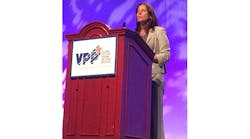VPPPA 2014: At General Electric, the Future of Safety Is Spelled ‘H-O-P’
Ann Klee summarized General Electric Co.’s new approach to workplace safety and health by comparing stop signs with traffic circles.
Stop signs create a rules-based system in which motorists “come to a stop, look both ways and move forward.” On the other hand, traffic circles – also known as “roundabouts” – force motorists to be engaged in the process of moving through an intersection.
“Everyone is engaged, everyone is alert, everyone has a role to play,” said Klee, who is GE’s vice president of corporate environmental programs. “They’re bringing their skillsets, their own observational powers, their judgment” to bear.
Klee, who cited data showing that accidents and fatalities are less frequent in traffic circles, said the concept is the premise of GE’s “HOP” approach to workplace safety and health.
“The key to HOP is accepting that human error is inevitable,” Klee told attendees of the 2014 National VPPPA Conference in National Harbor, Md., during her opening-day keynote address. “Once you recognize that you can’t eliminate human error, you can start to focus on risk.
People are going to make mistakes. So you have to focus on fixing the systems and not on trying to fix the people.
HOP – an acronym for Human and Organizational Performance – is based on a “fairly simple” principle, Klee explained.
“People work in the context of systems. People are going to make mistakes. So you have to focus on fixing the systems and not on trying to fix the people.”
Fresh Perspective
Over the past few years that GE has been applying the HOP philosophy to EHS, the iconic manufacturer already has enjoyed a number of wins, Klee noted.
In one GE appliance plant that was concerned about a spate of forklift mishaps in its warehouse, plant management initially believed that the best remedy was to install GPS tracking systems and impact detectors on forklifts and to require incident-prone drivers to get more training. After applying the HOP philosophy to the problem, however, the company came to the conclusion that “our approach was wrong.”
“During one of our reviews of the business, we came in – thinking about HOP – and asked forklift drivers, ‘Where are the best drivers in the appliance business?’” Klee explained. “Every single employee said the best drivers were in the warehouse. If that was true, why were we trying to fix the drivers and send them back to forklift driving school?”
HOP is now the way we work, and we're seeing the results in our EHS performance.
With the HOP approach in mind, the plant used the data from the GPS units and impact detectors to identify problem intersections, and then fixed them. Lo and behold, the number of forklift incidents went down dramatically, Klee said.
“That’s how HOP works. You fix the system. You put defenses in place, but you don’t try to fix the employees.”
'Program Fatigue'
From the get-go, GE decided that HOP wasn’t a new initiative, program or procedure, Klee emphasized, “because we had program and procedure fatigue.”
“It was a philosophy, and we started building it from the grassroots up,” Klee said.
GE developed eight-hour and 32-hour training sessions on the HOP philosophy, and the EHS professionals who completed the training “came out of it as enthusiastic advocates.” Since then, leaders from operations and other functions have asked to be trained on HOP.
“HOP is now the way we work, and we’re seeing the results in our EHS performance,” Klee said.
